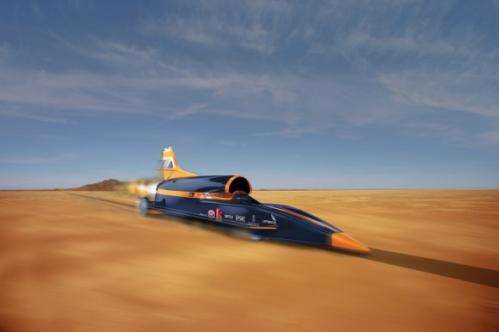BLOODHOUND team predict the impact of the 1,000 mph supersonic car

A new paper from the Swansea University, College of Engineering team working on the BLOODHOUND SSC (Supersonic car) project has been published on the aerodynamic characteristics of travelling at 1,000mph. Simulations have looked at how the car will cope with the supersonic rolling ground, rotating wheels and resulting shock waves in close proximity to the test surface at the record attempt site in Hakskeen Pan, South Africa. Where, in 2015, it will make high speed test runs of up to 800mph, with the full 1,000mph attempt scheduled for 2016.
In order for a ground vehicle to travel at over 1,000mph (approximately Mach 1.3), the designers have created the most advanced fusion of space, aeronautical and Formula 1 engineering ever attempted. In the words of the Institution of Mechanical Engineers, 'the BLOODHOUND supersonic car (SSC) is the most exciting and dynamic engineering challenge going on today.'
Clearly, the aerodynamic challenges associated with developing a land–based vehicle capable of safely travelling at transonic speeds are great. Drag minimisation and vertical aerodynamic force control are of paramount importance for a safe record attempt on the constrained distance of 12 miles available at the record attempt site in Hakskeen Pan, South Africa.
Computational fluid dynamics (CFD) has been chosen as the primary tool to guide the aerodynamic design of the vehicle. Dr Ben Evans and Chris Rose's work on the computational fluid dynamics of the project, developing models of the aerodynamic flows that BLOODHOUND will experience, helps guide the vehicle design. On working on the project, he said, "These computational models have already influenced significant design aspects of BLOODHOUND including the front wheel configuration, the shape of the nose, the jet engine intake shaping, rear wheel fairings and wing shape and size. The CFD modelling continues to be one of the dominant tools used to develop the surface geometry of BLOODHOUND."
The sheer audacious ambition of increasing the current LSR by over 30% meant that the BLOODHOUND design team had to start from scratch and not only design a new type of LSR vehicle, but also develop a whole new way of thinking. Their investigations into the issue of how to keep the vehicle grounded led to an unexpected discovery that the problem was more difficult to deal with at the rear of the car, rather than keeping the nose down at the front.
As noted by the authors in the paper:
'A series of unsteady simulations will also be carried out in order to determine the unsteady response of the vehicle, particularly in conditions such as deceleration with airbrakes deployed. It is also evident that there are still questions to be answered regarding the accuracy of the model, such as exactly how the shock waves will interact with the ground surface at Hakskeen Pan, particularly if the shock waves cause the surface to break up. This will require refinement of the CFD model in parallel with the testing of the vehicle.'
The BLOODHOUND Project was launched in October 2008 with a primary engineering objective of designing, building and running a car to achieve a new LSR of 1,000 mph. This engineering objective is coupled with an educational objective to promote science, technology, engineering and mathematics (STEM) to school children in the UK and beyond via the BLOODHOUND Education Programme.
More information: "Simulating the aerodynamic characteristics of the Land Speed Record vehicle, BLOODHOUND SSC" by the Dr Ben Evans and Chris Rose is a forthcoming article published by the Journal of Automobile Engineering. The article will be freely accessible here.
Provided by SAGE Publications




















